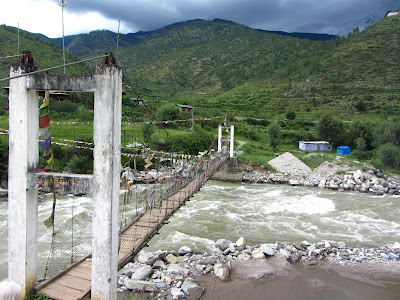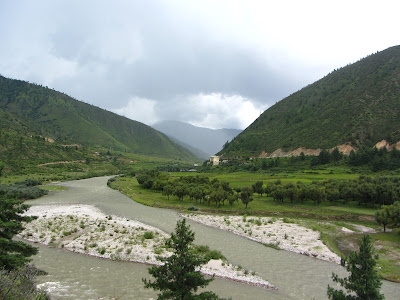I received a call Saturday morning from Doug, who is a senior advisor to RTC, asking if I wanted to go for a hike in the afternoon. I immediately said "Yes!" Doug and his wife Janet have been in Bhutan for over three years and have overseen the development of RTC from the very beginning. They are an older couple – Doug is a retired financial planner and Janet is professor emeritus in social psychology at the University of Pittsburgh – and they live in the building across from mine. Since my real grandparents are very far away at the moment, I guess they'll have to be my surrogate grandparents! I was very honored that they asked me, and it was nice that they did because it's hard to do things around here if you're not in-the-know. Doug and Janet also have a car, which is very convenient to get around in Bhutan.
My co-worker, Samir, was also invited along. Samir is of Indian heritage, but was raised in California and ended up going to graduate school at Stanford, so we had an immediate connection. His desk is also near mine in the faculty block.
We met in the parking lot near my building, just as it started to pour (good ol' monsoon season). Fortunately it cleared up fairly quickly. This is a picture of my apartment building from Doug and Janet's apartment building. My apartment is the one on the upper-left (with the brown and yellow detail).
Recognize this plant? If you do, the DEA has a few questions for you! As you might have heard, one of the quirky features in Bhutan is that marijuana grows wild everywhere. It is only recently that drying it and smoking it has been discovered here. Traditionally, marijuana leaves are fed to pigs and the local name for it literally means, "pig food." This picture was taken on the side of the road where we parked the car.
We drove south on the main highway and parked near a series of road-side shops. The village of Namseling is located down from the main road, so most of the shops sell produce from the village. This is an area that can be considered the South Thimphu Valley.
Typical river bridge crossing. It was pretty rickety and the Thimphu Chhu [river] was swollen and raging due below your feet due to all the recent rain. These kinds of bridges are always adorned with prayer flags, and now I know why!
Samir and Doug take the low-road, while Janet and I take the high-road. The trails we took were unmarked, and there were many that crisscrossed the floors and walls of the valley. These were mostly local trails for cattle, farmers, monks, dogs, and whatever else.
The ruins of an ancient house that could be 100 years old or could be 1,000 years old – it's hard to tell. Most houses and property remain in the possession of families for dozens and dozens of generations, passing down matrilineally to the oldest daughter. If a house is a abandoned, it means that some sort of misfortune struck that family and no one will re-build on the land because of bad omens.
Hanging out with the cows.
A large gourd hangs down from where the road was cut into the hills. Vegetables grow wild all over the place in Bhutan.
We walked up to a small and beautiful monastery overlooking the valley. The monastery is either new or undergoing renovations.
Doug, Janet, and Samir walk to the monastery.
Prayer wheels.
Peering into the windows, I was taken aback. The inside of this quaint little monastery was beautifully and ornately painted and there were several large golden statues at the altar. There were candles burning, but no one was around. This picture doesn't quite do it justice, as I pressed the camera against the glass.
Detail of outside painting.
Prayer flags overlook the verdant valley.
A typical Bhutanese farm house, with chiles hanging out the windows drying in the sun and a bin full of peaches ripening just below them.
On our way back down, looking north towards Thimphu.
On the trail with Doug, Janet, and Samir.
Entering the village of Namseling, crops abound. Here's corn that is planted around chiles.
Namseling Village.
Re-crossing the Thimphu Chhu.
Pausing for one last view of the valley floor.
Buying produce at the road stalls.
Another quirk of Bhutan is chewing on dried cheese. If you look at the above picture with Doug and Janet, you can see it hanging on the far right of the picture. Here's a closeup picture. You buy a string of cheese and pick off chunks to chew at your leisure. Sometimes you see people wearing them like those candy-necklaces back in the States. The cheese is rock-hard and does a number on your teeth, so – like doma – I don't think I'll make this a regular habit.
. . .
After the hike, we drove back to RTC and freshened up. Doug and Janet were meeting a friend in Thimphu, and drove Samir and I into town with them. Samir and I did a little shopping and browsing around, and then had dinner at Seasons Restaurant, which is the favorite pizzeria in town. It's pretty good considering we're in the heart of the Himalayas! Samir's friend Ugyen also joined us and we had a great evening eating pizza, drinking Bhutanese beer, and conversing. Ugyen works for the Foreign Ministry, so he has lots of good stories and insight. (His father is also the dean of the nursing school so, Emily, he's a good person to know!) Samir and I returned back to RTC later in the evening tired, content, and just a little buzzed from the Druk 11000 "Super Strong" beer. All in all, I would say that this was probably one of favorite days in Bhutan so far.




























The pictures are just beautiful!
ReplyDeleteJust curious - what's the Bhutanese attitude towards cattle? Are they sacred & wander freely, like in India? Or are they "owned" by certain families who control where they go?
ReplyDeleteCattle are sacred to Hindus and Jains in India but, of course, Bhutan is a Buddhist country so they are no more sacred than any other animal. All domesticated animals are free roaming, but all have owners. (Think of it like Vieques: most of the horses had owners, but they were left to their own devices most of the day.) In India, most cattle are also owned – it's just that it is against religious law to kill them (cows are revered for their ability to give food in the form of milk). Here's a good website that explains the cow's relationship to Hinduism: http://www.religionfacts.com/hinduism/things/cow.htm
ReplyDeleteIn Bhutan, cattle are frequently found in the road chewing on grass and I'm always amazing that more don't get hit by cars. I've had beef several times here as well, and its served every once in awhile in the RTC dining hall. Momos – the ubiquitous Tibetan dumpling – is traditionally filled with beef.
Great tips regrading Cannabis. You provided the best information which helps us a lot. Thanks for sharing the wonderful information.
ReplyDelete